Baltimore is a complicated city. It is a hard city to explain to outsiders. Quite often, it is a hard city to explain to insiders. In other expanding, growing urban environments, development is quicker, neighborhoods change, growth dominates and pushes through walls and forces tolerance and integration. However, Baltimore seems a bit stuck in a time warp, and urban development doesn’t match the likes of San Francisco, Cleveland, Atlanta, or Miami. We tried to affectionately call our city Charm City, but the irony was and is not lost on the generations of families living here, and around the city. Whenever I think about all of the crimes against me in all parts of the world, the drunk fights, the carjackings, the robberies, muggings, chasing away bullies, broken bones, or whatever, the tough girl always tried to come out of me to fight back because, hon, I’m from Baltimore.
So I might as well answer the two most often asked questions of the last four months. How did I become involved with the Arabbers of Baltimore City? And who are the Arabbers of Baltimore City?
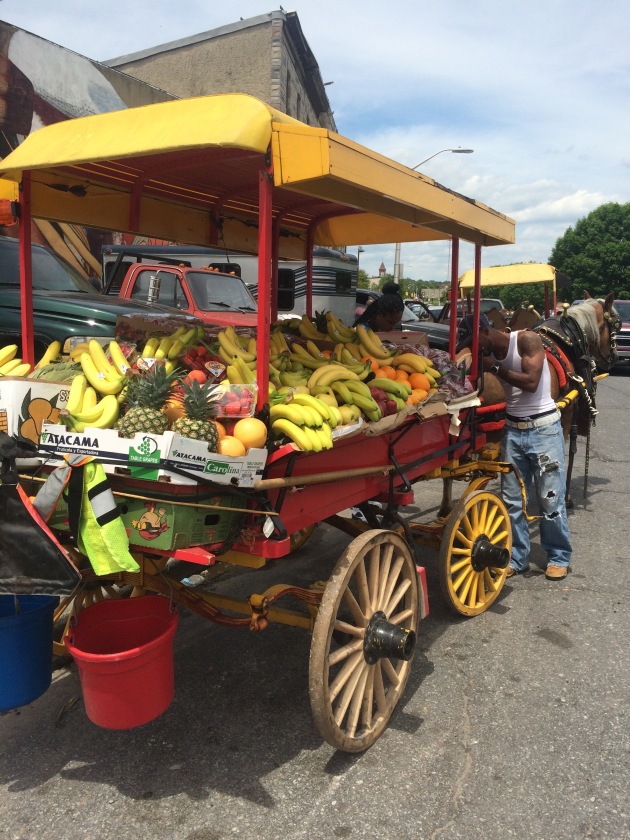
Haul for the day
Arabbers have been around forever, long before cars, and people used to sell every known item under the sun off the back of a cart, which was attached to a horse, which traveled up and down city streets like the ice cream truck and the Arabber (pronounced A – rabber) would shout or “holler” about the items in the cart as he (or she) passed through your neighborhood. Generally around here, since cars and trucks have really taken over, Arabbers have had to fight with the city to keep their tradition alive, mostly by insisting that the produce they carry is the only produce being offered in an alarmingly large portion of Baltimore City. It is true. The massive amount of concrete jungle on which nothing but a tiny, heavily barred and surviellanced corner store exists is frightening and depressing. And in those corner stores, there isn’t likely to be any fruit. I’m not kidding. Add to the lack of grocery stores, poor urban development, and unwillingness of banking institutions and other businesses to open in certain areas, and you have what is popularly known as a ‘food desert’. What happens if you don’t have a car? Guess what, a lot of people in Baltimore City do not own a car. What happens when it is not possible for you to leave your home? Another guess, most people are not able to spend an entire day trekking around town, waiting in the heat for a bus that might show up, (or spending more money on transportation than groceries), looking for proper nutrition. Or an open bank. Baltimore city has one of the largest food deserts in the country and is not likely to be changing anytime soon. Growth is so damn slow around here, it is no wonder we are considered a city stuck in a time warp. We have major issues, endless obstacles, and even when it seems one hurdle is cleared, we might be moving forward, at least a half a dozen fresh problems pop up, and boom, we are back at square one. This summer was particularly bloody for reasons most of will never really be able to comprehend, and the grief lingers with the haze, making you want to push the awfulness aside and search for ANY positivity in ANY corner of the world.
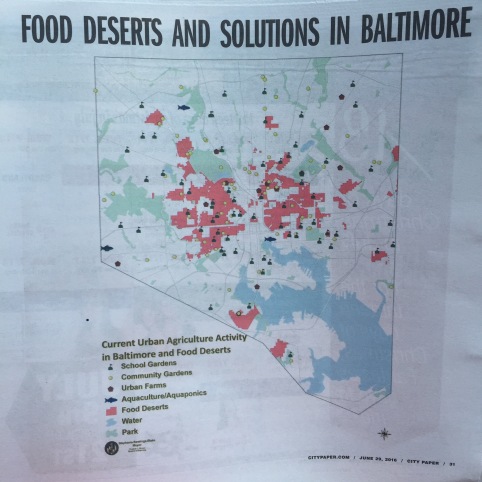
The City Paper posted a convenient map. the RED is the food desert. not good.
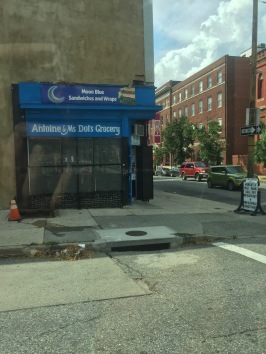
a couple of these exist
Without having broken my leg, (for which I should have been resting quietly in bed), the Arabbers never would have crossed my line of vision, and I would have only been updated through Equiery posts, or brief mentions of their problems somewhere in the City Paper. However, within under a week post surgery, I had just about enough of staring at my own walls, and begged someone to come pick me up and take me to a horse related meeting. I was looking for my next blog post.
Watching a room full of horse people is hilarious to me, my sarcasm radar gets sharper, my face develops a tiny smirk, and my eyes twitch with this weird battle to prevent an unwitting eye roll. Way better than Netflix. For real.
The meeting carried on, I took a few notes, checked Facebook thirty or forty times, and made a mental list of things I should really order on Amazon, now that I had upgraded to Prime. Then the floor opened up to New Business, and someone captured my attention. This strange looking and not really horsey man had ventured up to our little meeting to tell us the situation with the Arabbers in Baltimore City, and ask for ideas on how to move forward. I was totally hooked the second he opened his mouth. I wanted to write that story. It had everything I wanted in a piece, and despite only ten minutes of exposure to it, I knew I was totally throwing myself into it. I friended two names immediately on FB, and sent a group message saying I wanted to write their story, please let me, maybe I can bring some attention to you and let’s see what happens. By the time I stood up to leave, Holden was gone, disappearing from the dullness of horsey things being covered in the State of Maryland by an enthusiastic group, and I could hardly chase him down on one leg, and I needed to eat. He did, however, respond to my message, and invited me to the work detail to help clean up the yard.
That was in four months ago in April. Now they can’t get rid of me. Before I could even walk I was hobbling around their yard on pink crutches, absorbing every little detail, desperately trying to learn names of people, names of horses, make countless mental lists and written lists about improvements, clean up, direction, and survival. I met a whole slew of new people sharing the same drive to keep the doors open, and think it is an incredible team. We might be in a constant state of “where do we begin?” but at least the energy is there.
The horses look great, all sorts of junk has been hauled off, making room for future improvements, equipment areas gutted and cleaned. “Fruit”, who is in charge of the yard, hustles all sorts of horse related business on the side, showing up with ponies at birthday parties, taking prom queens for a carriage ride, weddings, funerals, you name it, he can probably swing it. The main priority is keeping food flowing through the neighborhoods, and keeping the horses around that are capable of doing that, but there is still the concrete cowboy in Fruit who deserves to see the city from a back of a horse. And he wants the next generation to have that access as well. #inspiration. I have always firmly believed in animals integrating into city life, but not just cats and dogs, larger ones, too. There are so many city dwellers who NEVER learn what it is like to be around a pony or a horse and that simply just doesn’t seem fair. Everyone deserves to know a horse, learn about one, feel, one, smell one, learn to lead one, draw one, photograph one, learn to feed one a carrot. There is no reason horses should be limited to people outside the city who are lucky enough to drive a car and travel down country roads. If horses were our main mode of transport as they were 100 years ago, it would never occur to any of us that city horses are rare, because last century, the city was full of stables.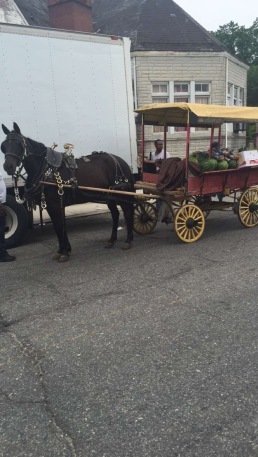
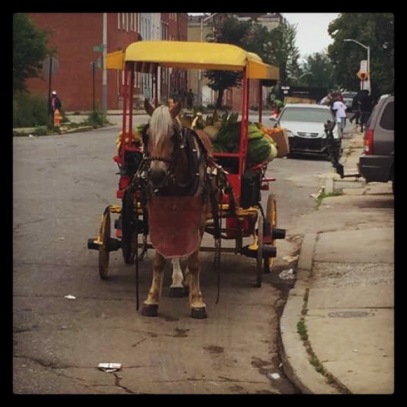
I met a lady Arabber. I didn’t even realize there were any lady Arabbers, but I met one! Jackie just strolled in one day while I was hanging around the horses, and she just started chatting away, telling us all sorts of stories about who she knew, where she Arabbed, and what was going on now. She didn’t know the Fremont Avenue Stables, (I think she came from the old Bruce Street Stable before she retired) so thought she would check it out, see if she could bring her husband along one day and go for a ride. How awesome is that? She described her past horses in incredible detail, had learned the tradition from her father, and was on the streets hollerin for a good twenty years.

Jackie once Arabbed the streets of baltimore
There is nothing easy about being an Arabber, you don’t do it for the money, I can assure you. It is work, real work, and you are always repairing your cart, chasing down runaway melons that plop off the side, or getting soaked in the rain. If you don’t have a clear cart when you head back home, you walk it in, if you have sold every piece of fruit on your wagon, you can ride in. Each little detail has come from some tradition passed down in families, learned from a grandfather, or cousin, and the will to keep it all alive is incredibly fierce. Every single Arabber has a story to tell, and the ones no longer around have their faces painted on walls around the neighborhoods to remind us all of their own colorful lives.

BJ getting Tony ready

BJ’s shadow, future Arabber
Community support has been tremendous, I have to admit. Everyone wants to talk about it, contribute, volunteer, offer something, anything, a load of hay, ‘squishy’ horses, books for the coming library, and we are definitely heading in the right direction, despite the usual hurdles and complications. I have learned a lot. I have lost a lot of sleep over it. The sheer magnitude of capital improvements needed in the yard would normally be shouldered on people with maybe a tad more experience, and better connections, but non the less, we all get along and envision the same thing for the city stables. In the past, the horses have bounced around several locations, but now have a permanent home on Fremont Avenue in Sandtown, which the non-profit (The Arabber Preservation Society) currently owns. We envision the property being an open, operational Horse Discovery Center, fully licensed by the city and the State, a safe zone for children, a learning center for anyone who wants it, and a thriving hub for produce on the edge of a massive food desert. We have already accomplished a lot, but have a tremendous amount of work ahead of us.
You can tell me I am going to fail, you can look at me sideways while you are trying to figure out what in the world has possessed me to become involved with this particular Non-Profit organization. It won’t matter to me or the team, we are doing this. We are going to do something.
teaching this little guy about cleaning tack
The tumultuous year in Baltimore that seems to keep the helicopters buzzing and funeral directors afloat has not been lost on me. I get that most of our country is actually deeply wounded, and will take an incredible amount of tiny miracles to heal, if it ever even does, who knows. It is partly why I have been desperately seeking attention from one other slightly smaller stable in Charm City, located on another side of town, yet directly under a popular highway linking Maryland’s infamous horse country in Greenspring Valley to Fells Point. The two city stables are ten minutes apart by car, but worlds apart on every other level. And no less fascinating.
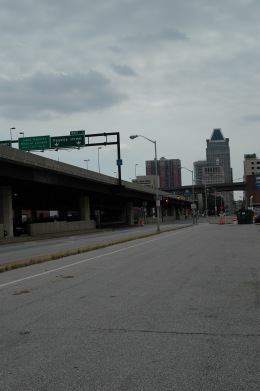
The stables for the BCMP are underneath that highway
I finally gained entrance into the Holliday Street Stables to talk to the men and women who may have a completely different take on city living than anyone else I know. However they all tack up horses the exact same way you and I do and exactly the same way the Arabbers do, one ear at a time.
These working horses are massive, all draft crosses, one named Hercules is an impressive 18 plus hands, and grey, poor thing, so he sees a lot of baths. There are only 6 at the moment, the wish list has four more on it, but regardless, it is not a large unit compared to other cities. There is no sergeant at the moment. The closest to that rank is Janine Gilley, a ridiculously capable woman with nearly two decades in the Baltimore Mounted Police Unit. Not only can she ride, and police, but she shoulders all of the training, choosing of the horses, feed, bedding, grain, vet, blacksmith, staff, and hundreds of other details that come with horse management. If you ever need a reality check and are feeling overwhelmed with responsibility, take a moment to wrap your head around what she does and you will instantaneously feel better. Trust me. You can’t do what she does. Because she is superwoman and does everything, then uses horses to roam the streets for bad guys and hauls their asses in when they break the law. Her tiny army of 6 is a cohesive group. Some of them are from around Baltimore, some are from places like Jersey, or the Carolinas. They all had to take an intensive six week training course on not only learning how to ride, but on all horse management skills, feeding, mucking, identifying lameness, and troubleshooting everything horse related. The rest they picked up on the city streets.
From what I could learn about a regular police horse day, it is generally evening work on the weekends. And it is work on the Block. For those of you unfamiliar with the Block, it is a part of Baltimore Street, which holds a variety of strip clubs, and bars, and sees a fair amount of illegal activity involving guns, drug trafficking, stolen cars, etc. – use your imagination for the general content or remember pretty much every case seen on The Wire. You get the idea. The weekend night shift is like 7pm to 3am, and the advantages of using horses to police comes from several angles.Height for one. You can only see so high in a squad car. But on a towering draft or draft cross, you can see almost to the second floor of a building, above crowds, and further down a city block.
Agility… Yep, those big lumbering horses move way quicker than a squad car, and acceleration in a foot chase is unmatched. These horses even know how to sort of pin an assailant into a corner and just leeeean on them.
Smells. If you pull up to a stoplight, are smoking weed and your sunroof is open, I am gonna guess John Potter and his pal Hercules are probably gonna identify the issue rather quickly, step all 2400 pounds in front of the vehicle and tell you to find the gear for park…
Outside of the evening work on the Block there is other stuff. Crowd control is key to these horses. Ray Lewis knows this first hand when fans were getting a teensy bit too dramatic and wanting to invade his personal space and it took every one of the six horses to intervene and keep his limbs intact in that infamous Ravens parade.
Drill team exercises are practiced constantly to work crowds, changing the formation to adapt to an environment, and tight ranks is the ‘survive or die’ tactic used to keep these officers on their steeds. Paramount in our city.
During the week the daytime shift is significantly earlier, and they work through neighborhoods like Mount Vernon, close to the stables, and following them out one day, I watched people react to the horses walking past, and passengers in cars snapping away at them. Jersey Girl always waved, seriously quick to engage eye contact with people in cars, on the street, and even above on scaffolding.
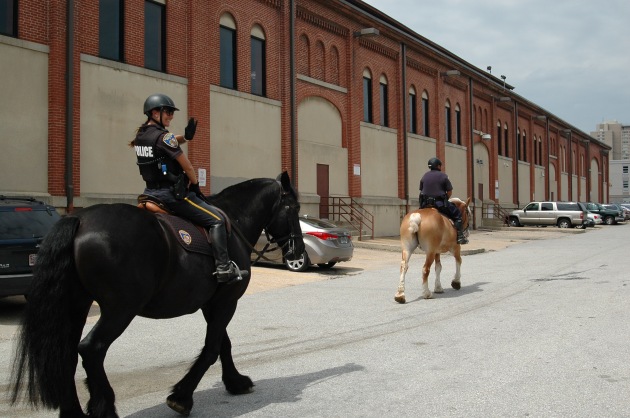
Janine Gilley finds most of these animals from the Amish, and I can assure you each and every one is ever so thankful to leave that Amish life behind to be a city horse with steady meals, fresh water, and exceptional vet care. She pushed the lighter breeds out for sturdier types, which has worked remarkably well. After other cities started pulling shoes for the draft horses, Janine followed suit, discovering almost 7 years ago, the traction was better, and after training her riders to keep a slightly keener eye on the ground, it became pretty natural of them to go barefoot. I think this can be used in the other city stables, actually, because many of those horses have weekend jobs and shoes seem sort of pointless. Plus, hello? Can we please the budget director any more than saving on that big ole blacksmith bill?? I did notice the saddles were all Stubben Siegfrieds, which I thought a little peculiar, but there has been some consideration to switching to Western, which might provide more comfort, stickability, and why not be able to lasso a robber and keep him handcuffed to the horn? lol, brilliant, and it worked for that one guy out West who recently caught the purse snatcher from the back of his horse at Target, right? I don’t know if the BCMP has the luxury of switching gear that easily, but it is something to consider for the future. My ass is sore just thinking about those Stubbens. No offense Stubben, but really, what gives with that seat?
I met Janine ages ago through Maryland Saddlery, and have followed the BCMP off and on over the years, many of my friends have offered up their farms for officer training, so the entire unit is well known with horse people in Baltimore, Harford, and Howard Counties, and she has been an incredible ambassador for the City Police. Not only is she genuinely a nice human being, she is supremely dedicated to the history of the mounted police throughout their last 128 years. Almost every scrap of newsprint or media has been captured in album after album, which she put together, and her knowledge of Baltimore, and of Maryland is hard to fathom. I just wanted to know when the first woman joined the unit, because you know, #gurlpower, and as it turns out, we not only boasted the first woman to join the City Unit, she is considered the first woman in the COUNTRY to join a mounted unit, and awesomely, she was African – American!! Her name was Janis West. An article in the Baltimore Sun says Janis had no experience riding a horse at the age of 23, but in 1979, her bosses decided they wanted to see women riding horses in the mounted unit, and she, “being an adventurous type”, jumped at the opportunity and proved to be worthy in every kind of detail, in every kind of neighborhood, for the next 20 years. She rode an ex-racehorse named Cady, and apparently generated an enormous amount of income for the city by distributing a prolific amount of tickets near Lexington Market, and I gather there was no middle ground on whether or not you liked Janis West, depending on whether or not you ever bothered to put money in your parking meter… She served for twenty years.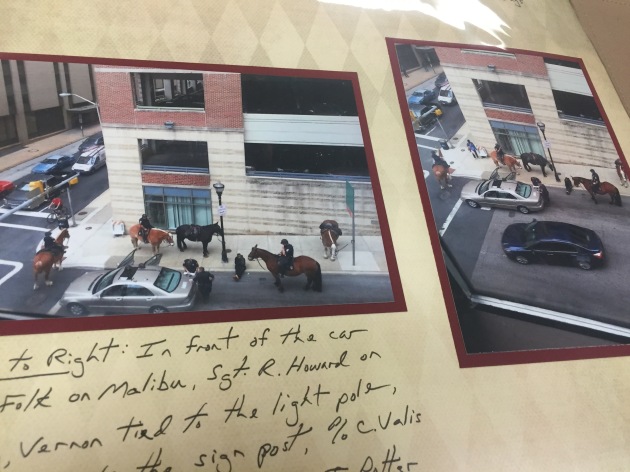
So much documentation of the history of Mounted Police
The Baltimore Sun has followed the Mounted Police extensively for years, and every once in a while will glorify a bad accident involving a horse, because… Media. But as a rule there are far more city horses retiring to farms in the counties (waiting list, don’t even try) than tragically in the streets. If you spend your life as a horseman you will experience horses living, or dying at inopportune times, but country horses have more untimely deaths than city horses, trust me. Paddock accidents happen everywhere. We have all had them. Don’t even try to argue with me.
One of the more bizarre stories that came out from the officers, was the day they all learned they were out of a job by way of a newspaper. No warning, no notice, just the front page of the Baltimore Sun announcing city budget cuts, and whoosh, mounted patrol gone, kind of like learning you are broken up by your boyfriend by way of a post it note. Yeah, people actually do that. Even more peculiar was that when word spread of the impending doom of the horses and riders which had also served as ambassadors for the City Police since 1888, an anonymous donor stepped in and said, uh no, the horses stay, and here is TWO YEARS worth of funding to keep them here… Blink… Blink….Blink. Our community has spoken about how they feel about equines, apparently. And someone privately held police horse duties to a very high level, which is not surprising when you think about it. How many people do you know want to take a selfie with a police horse? Pet one? Good grief, I have done it all over the world. Police horses are easy to identify with in the street, like the carriage horses in NYC, they just scream PET ME. And it is allowed here, encouraged, as long as you don’t put a finger or five too close to the teeth like an idiot.
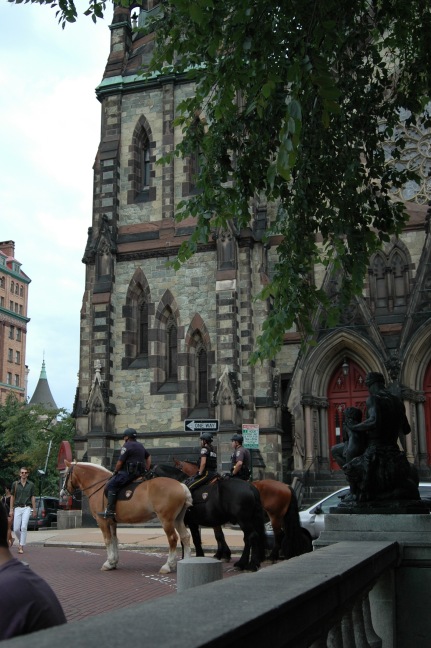
In Mount Vernon
Maybe the way forward is to be set by example from our horsemen and women around the city of Baltimore. Charm City. Less of Murderland, more of Maryland.
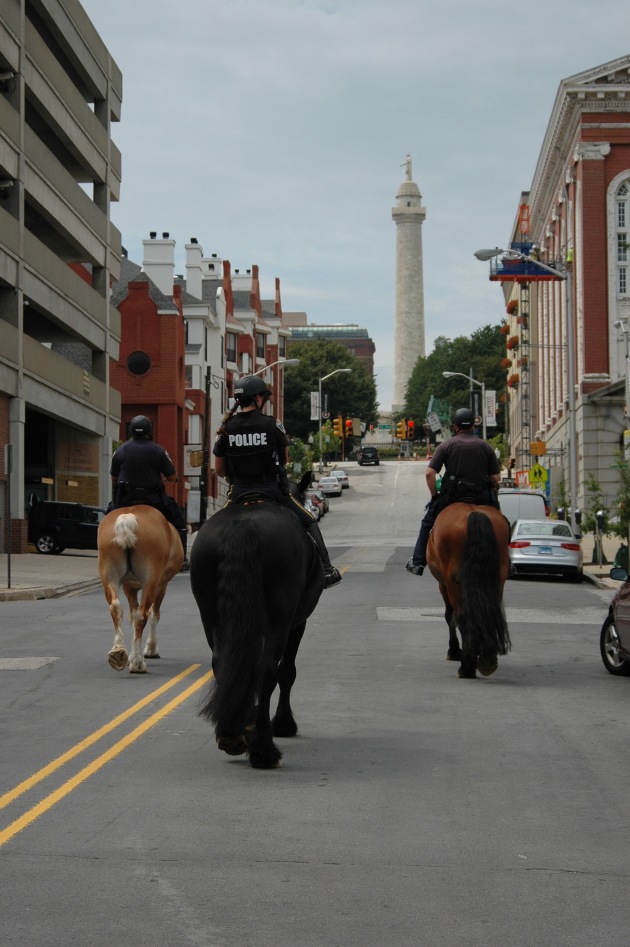
Going to work, Washington Monument in background













Thank you for this. I always read your posts but rarely comment. This one really moved me. Please know that people are reading, thinking, and learning from your columns, even if you don’t hear from them. Would love to hear more about the Arabbers in a later post.
LikeLiked by 1 person
Love your blogs Del. You’re awesome. Do the Arabbers need horsie stuff? Or do the mounted police? I have a ton of grooming supplies, some tack, boots, wraps and old blankets. I’m happy to drop off if you want to give out contact info. If not the stuff can happily go to a rescue. : ) Thanks!
LikeLiked by 1 person
Yes always, if you are unable to take the items you would like to donate to Maryland Saddlery and list them under the Fremont Ave Arabbers, then you can always get them to me and we will take care of it. Whatever items either facility cannot use themselves, we will sell through consignment and buy items they do need. Many thanks! xo
LikeLike
I have had a life with horses that began with the Arabber that woke me ever Saturday morning. I fell head over heals in love with horses as a 5 year old. I even got to lead the cart horse up and down the street. What a thrill for a city child.
Now 70 years later after a life of raising and showing horses in Harford co. I can say thank you to that nice man who let me lead his horse and started my life course of loving horses.
LikeLike
Great Article! Well written & great pics! I loved reading about the Arabbers. I drive & still see horses having positive & rewarding lives interacting with people in cities & providing a valuable service too. I have an elderly friend lives in NW Baltimore. The food desert is very real & for some folks another way of keeping an eye out for their health & creating community.. BCMP are great. Would love to see more mounted officers. Don’t bash those Stubben saddles though. I was involved in supplying those some years back. They are only just starting to break in by now & will hold up well. Officers need to be able to dismount fast too which is why they were originally selected over Western and less weight for the horses. Good enough to carry the Gold medal winner in Rio!
LikeLike
Thank you! I grew up riding in my Grandmother’s Stubben Seigfried, so it is a little tongue in cheek, but you are quite right. It is a good saddle, however, my bum did notice a significant difference when I switched to my first French saddle, lol. Thanks for the great reply though, xo
LikeLike
Wow, I’ve never even HEARD of a food desert before!! What an awful situation.
Great post, thank you!
LikeLiked by 1 person
So glad to see a positive article about horses in the city. (There are even people who think having a dog in the city is cruel.) I have been a member of the Arabber Preservation Society since the 90’s. I donate wheelbarrows that I buy from the auction every year. I am also on the Maryland Horse History Trail project through the Maryland Horse Industry Board. Two of us have been assigned Baltimore City and I feature the Arabbers and the Mounted Police along with historic Pimlico and numerous other sites that relate to how important equines are and have been to all of us. Thank you so much!!!
LikeLiked by 1 person
Fabulous Deloise! Absolutely fabulous!
LikeLiked by 1 person
Once again you did it with class. What a wonderful article. Thank you so much. How do we make donations to the Arabbers or the mounted police?
LikeLiked by 1 person
Yes the Arabbers would LOVE some help, there is a lot of work to be done, and need just about everything under the sun. This week we hope to have a PayPal account set up on the http://www.arabbers.com site, or checks can be mailed to The Arabber Preservation Society 1001 North Calvert St Baltimore 21202. If you contact anyone in the Police Department, they will hook you up with Janine for donations. I know they would be interested in some hay, as they lost about 50 bales last week when the stables flooded.
I will be hosting a fundraiser at the Greene Turtle in Hunt Valley in September, where a portion of the entire day’s meals can be donated to the non-profit (and I will post details on Facebook), so all you need to do is eat and you can give!
LikeLike
Wow Deloise This is one of the best pieces on horses & horsemanship I’ve read in a long time. Please continue all your amazing work that you are doing and inspiring others to join you.
LikeLike
great
LikeLike